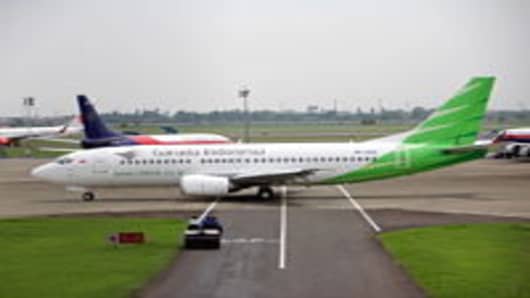While Europe's debt crisis and global economic uncertainty are threatening airline profitability in the West, in Asia airlines are experiencing relatively strong growth.
According to forecasts from the International Air Transport Association (IATA), carriers based in Asia Pacific will make profits of $2.1 billion in 2012. That's 60 percent of the total profits of $3.5 billion predicted for the global airline industry.
But below the surface, there's a growing risk to the health of the region's airline sector from increased competition. Airlines in Asia are adding capacity at such a rapid clip on international routes that industry watchers are growing alarmed.
Airline CEOs will be meeting on the sidelines of the Singapore Airshow this week to discuss the challenges facing the sector.
"It does look like there's going to be a substantial increase in capacity this year as new aircraft orders arrive and as new carriers enter the market, or existing carriers enter new markets," Peter Harbison, Executive Chairman of CAPA — Centre for Aviation, told CNBC in an interview.
IATA's numbers back this up. In 2011, international traffic in the Asia Pacific region grew 4.1 percent, but airlines added 6.4 percent in capacity.
Three large orders from Asia set new records for their size and ambition last year. Indian low-cost carrier IndiGoplaced the largest-ever order for 180 planes from Airbus, only to be trumped days later by Malaysia's AirAsia, which placed an order for 200 aircraft. A few months later, Indonesian airline Lion Airbecame Boeing's largest customer with an order for 230 short-haul 737 aircraft.
"If you look at 2010, it was a fantastic year, everybody was doing well, and in order to keep up with that growth everyone began to add capacity," Siva Govindasamy, Deputy Asia Editor at aviation publisher Flightglobal, told CNBC.
He says airlines are already beginning to see pressure on their yields — the amount of money they make per passenger mile — because of the increased capacity.
The China Factor
But there could be one “game changer” for Asia’s airlines in the coming year — and that’s the millions of Chinese tourists expected to travel abroad.
According to China National Tourism Administration, Chinese tourists made 57 million outbound trips in 2010. That’s expected to rise to 100 million by 2015.
CAPA’s Peter Harbison says the impact could be potentially enormous, especially for the North Asian triangle of Japan, South Korea and Northeast China. He says if governments in the region were to deregulate the market, North Asia could see 200 million additional passengers per year.
Another key, says Harbison, is to get more international flights connecting tier-2 and tier-3 cities. “It's not just the ability to fly, it's the accessibility of airlines… If you have flights between Nanjing [in China] and Kyushu [in Japan], you suddenly start simulating a huge amount of growth; you've just built a road that now opens whole new markets.”
Low-Cost Boom
Experts say much of the future growth in both North Asia and Southeast Asia is going to be driven by low-cost carriers, given the fact that many countries in the region have a burgeoning, price-conscious middle class.
Indonesian budget carrier Citilinkis typical of this trend. The carrier, which had just two planes in 2008, has nine in operation currently. That is expected to grow to 20 by the end of the year. In 2011, it ordered 25 A320 planes from Airbus , with an option for an additional 25.
"The growth market is the low-cost market. It's fares-driven rather than service-driven, and it's commoditized, particularly short-haul flight," Con Korfiatis, vice president of the carrier said. "It's really about the destination, rather than the flight itself... People are saying I want to get there on time and safely, but I want to get there cheaply."
According to him, the premium market in Indonesia is growing at seven to eight percent, while the budget market is growing at about 20 percent.
According to Flightglobal's Govindasamy, there is still a lot of scope for low-cost carriers to grow in Asia, given their relatively low penetration compared to the West.




